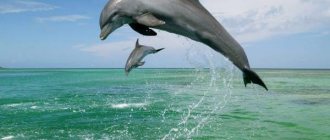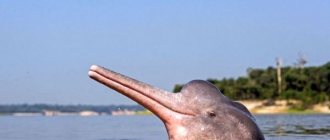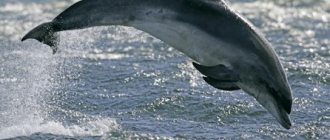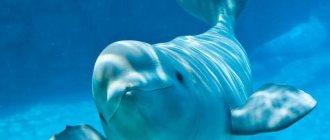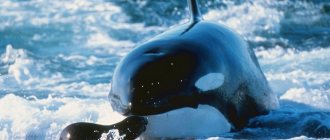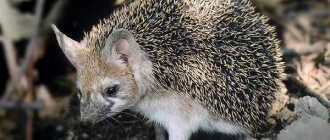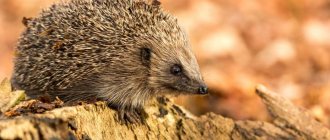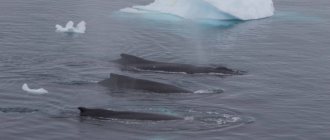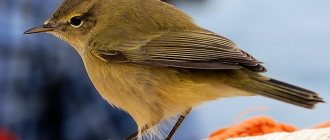- Wild animals
- >>
- Mammals
An elegant body, a smiling face, immense curiosity for humans and a cheerful disposition - yes, this is all a bottlenose dolphin . Dolphin, as many are accustomed to calling this intelligent mammal. He has the most good-neighbourly relations with the person. Today, there are already dolphinariums in every coastal city, where everyone can make their dream of swimming with dolphins come true at a reasonable price. But is the bottlenose dolphin so cute and harmless?
Description of the bottlenose dolphin
Body length 2-4 m. Weight 150-300 kg. Males are usually slightly larger than females. The “beak” is moderately developed and demarcated from the forehead. The length of the skull is about 60 cm. On the back there is a high fin with a wide base and a semilunar notch at the back. The fins on the chest have a wide base, pointed tips, with a convex anterior edge and a thin concave posterior edge. The body of the bottlenose dolphin is dark brown above, light, gray or white below, with a weakly expressed and inconsistent pattern on the sides. The dolphin does not have sweat glands, and a layer of fat serves as thermal insulation. In water, heat exchange occurs with the help of fins, which overheat without water and cease to perform their functions, which is why the dolphin dies.
Dolphins are the best sea rescuers
Dolphins live in family pods, which may explain their mutual assistance and developed cooperation. They always help their wounded or simply weakened relatives to stay on the surface, preventing them from drowning by pushing their bodies upward. Stories about such cases of helping drowning people are not uncommon; it is suggested that dolphins may treat humans as relatives. Legends about dolphins helping people are numerous, some of them go back to ancient times; others are more like fairy tales; in any case, there are still no proven cases of dolphins being hostile to humans.
Feeding characteristics of the bottlenose dolphin
— Advertising —
The bottlenose dolphin mainly feeds on a variety of fish. Depending on the specific region of its habitat, its diet may include horse mackerel, anchovy, haddock, flounder, mullet, mullet, red mullet, umbrine, anchovy, bonito, sea ruffe, stingray, octopus, shrimp, shark, eel and molluscs. The bottlenose dolphin needs 8-15 kg of fish per day. Hunting is determined by the nature of the prey and its quantity. If the fish is a diurnal fish, then the dolphin hunts in schools; as a rule, nocturnal fish are hunted one at a time. When hunting, dolphins help each other by emitting special whistles and forming a school that traps fish. Additionally, dolphin sounds can disorient and deafen fish. Hunting is also carried out during the day when there is a lot of fish. If there is not enough of it, then the bottlenose dolphin switches to night fishing for octopuses and bottom fish.
Dolphins transmit dozens of sound signals
Photo: www.illumina.com
The sounds made by dolphins, such as whistles, clicks and trills, are heard far out to sea: water transmits sounds much better than air. Some dolphin sounds are ultrasonic, so we can't hear them. These very high frequency sounds are used for echolocation . Ultrasonic waves reflected from underwater objects return to the dolphin, informing the animal about the distance, size, shape, direction of movement and speed of the object. This is how they learn about the whereabouts of other family members and navigate the rather muddy waters of the Black Sea, especially in coastal waters.
Dolphin show trainers use ultrasonic whistles to command their dolphins to perform a trick.
Distribution of the bottlenose dolphin
Bottlenose dolphin species live in the temperate and warm zones of the World Ocean. In the Atlantic Ocean they are observed from Greenland and Norway to Uruguay, Argentina and southern Africa. In the Indian Sea - from the Red Sea in the north to the southern latitudes of the African continent and Australia. The Pacific Ocean includes Japan, the Kuril Islands, Oregon, Tasmania, New Zealand and Argentina. The total number of individuals in the population is currently unknown.
Common bottlenose dolphin species
Bottlenose dolphins represent the family of dolphins and the order of cetaceans. The genus consists of three species:
- The common bottlenose dolphin (Tursiops truncatus) includes two subspecies:
— Advertising —
- The Far Eastern bottlenose dolphin (Tursiops truncatus gilli) inhabits the waters of the Pacific Ocean and is distinguished by a black line running from the eye area to the forehead.
- The Black Sea bottlenose dolphin (Tursiops truncatus ponticus) is an inhabitant of the Black Sea.
- Indian bottlenose dolphin (Tursiops aduncus) - found in the Indian Ocean, northern Australia, southern China, eastern Africa, in the waters of the Red Sea, distinguished by a dark gray back, light belly with gray spots.
- The Australian bottlenose dolphin (Tursiops australis) has recently been identified as an independent species and lives near Lakes Victoria in Australia.
Brothers in mind for man
The Black Sea bottlenose dolphin is also an object for scientific research - its sociability contributes to this.
Scientists are trying to understand the way dolphins think, decipher their language and achieve mutual understanding with them. These creatures are the only ones on the planet that are truly close to us in terms of their level of intellectual potential.
Military programs with the participation of bottlenose dolphins are not currently being implemented in Crimea - there were such programs before. But research on their possibilities in medicine is progressing successfully; there have been significant achievements in this area. Dolphin therapy has already been successfully used, in particular, for infantile paralysis and autism.
Scientists are confident that they will eventually be able to come to an agreement with bottlenose dolphins, and humans will no longer be considered the only intelligent species on the planet.
Reviews from those who were lucky enough to see Black Sea bottlenose dolphins in the wild are unanimous: no description can convey the cheerful charm of this picture. This is a chance for humans to become better, and for dolphins to survive.
Liked? Share with your friends!
Bottlenose dolphin behavior
Bottlenose dolphins lead a sedentary lifestyle or roam in small flocks. They usually stay near the coast, as they have a bottom-feeding nature and are active during the day. They dive for fish in the Black Sea to 90 m, in the Mediterranean to 150 m. Diving to 400-500 m is possible. During the hunt, dolphins move unevenly, often making jerks and sharp turns. The breathing pause lasts a couple of seconds or 6-7 minutes. The maximum speed is 40 km/h, the jump from the water reaches 5 m. The bottlenose dolphin is characterized by a complex vocal apparatus, which it controls perfectly. Dolphins communicate with each other at a frequency of 7-20 kHz using whistling, barking, meowing sounds and claps. Underwater they produce echolocation clicking sounds at a frequency of 20-170 kHz. The bottlenose dolphin sleeps next to the surface of the water, at night, during the day - occasionally after eating, the eyelids open for 1-2 s and close for 15-30 s. With a weak blow of the tail, the dolphin is periodically pushed out of the water and performs a respiratory act. While one hemisphere is asleep, the other is awake.
Dolphin skin is like silk
Dolphin skin is a wonderful tissue, capable of dampening turbulent whirlpools that usually slow down any swimming activity. This is another secret of the very fast movement of dolphins. The designers used the skin of a dolphin as a model for making covers for submarines. The appearance of dolphin skin is deceptive: it looks like hard, shiny plastic, but when you pet a dolphin as it swims by, it feels like you're touching fine silk.
Bottlenose dolphin breeding
Bottlenose dolphins breed in spring and summer. The duration of pregnancy is 12 months, the rut lasts from 3-4 days to weeks. At the same time, in captivity, dolphins take special poses, bend their bodies, jump, “sniff”, stroke each other with their heads and fins, bite and often squeal. The male drives away all other males from his female. A pregnant female becomes less sociable, clumsy and slow. The birth of the calf occurs under water with the tail first. Childbirth lasts from 20 minutes to 2 hours, after which the umbilical cord breaks, and the newborn, along with the mother and one or two females, floats to the surface of the water for the first breath. The mother feeds the baby, turning on her side to give him access to the nipples. At first, the baby does not swim far from her, then he begins to swim freely. It switches to solid food at 3.5-6 months, milk nutrition completely ends at 18-23 months. Bottlenose dolphins reach sexual maturity at approximately 5-6 years of age.
Dolphins love to play
Sometimes, when boarding a ship, we can see dolphins taking up space in the bow wave and traveling with it, jumping and playing in the flowing surf. Dolphins really love to play. These are animals with complex behavior and a well-developed brain: with the help of games, young dolphins learn signals, rules of communication and interaction in the family, hunting methods and many other tricks. Besides being useful educational games for the young, dolphins sometimes seem to just enjoy playing. Dolphins are especially funny playing “volleyball” with a large rhizostomy (a type of jellyfish), knocking it out of the water with their muzzle.
Natural enemies of bottlenose dolphins
Every year, mass killings of dolphins and bottlenose dolphins are carried out around the world for their meat; a number of individuals are also caught for dolphinariums. Dolphins die when they become entangled in nets and are shot by fishermen. In addition, people catch a large amount of fish that dolphins feed on and pollute the ocean, which causes the bottlenose dolphin to deplete its food supply. Another serious threat is ocean pollution from household, agricultural and industrial waste. Dolphins die in oil spills. The man-made problem also consists of noise pollution. Ship engines, echo sounders, and oil platforms create a constant noise that spreads over long distances in the water, creating an acoustic “fog” that interferes with communication, orientation, food acquisition and reproduction of dolphins. As for keeping in captivity, bottlenose dolphins often get stomach ulcers and bacterial infections.
Almost 70 years ago, over a million dolphins lived in the Black Sea
People living on the Black Sea coast have always hunted dolphins: their skin was used to make fabric for waterproof clothing for fishermen, the fat was burned in lamps, and the meat was a perfectly acceptable meal. By the mid-twentieth century, all species of Black Sea dolphins were in danger of extinction. It is estimated that there were more than a million dolphins in the Black Sea in the early 1950s, but over the following years they have been caught on an industrial scale. In fact, from 1958 to 1966, more than 440,000 common dolphins were killed !
Since 1966, given the high risk of extinction of these animals, most Black Sea countries have banned dolphin hunting. Türkiye joined the ban in the 1980s. Since then, the populations of all three dolphin species in the Black Sea have gradually recovered, and although their current size is unknown, scientists estimate they number in the tens of thousands of individuals.
For example, the blunt-faced dolphin, the smallest and most hunted species (its fat was very highly valued), was very rare in the 1990s on all coasts of the Black Sea. It can now be seen along the Caucasus coast, and in some areas off the coast of Crimea it has become common, sometimes outnumbering bottlenose dolphins (for example, at the entrance to Balaklava Bay).
Today, reported dolphin deaths occur primarily due to overfishing of dolphins' primary prey (mullet, sardines, anchovies, and anchovies), water logging, entanglement in fishing nets, and diseases caused by pollution.
Interesting facts about the bottlenose dolphin:
- Bottlenose dolphins are capable of behavioral imitation of humans. Scientists also determined their ability to generalize rules and create abstract concepts, monitor their behavior, understand symbols and pointing gestures, and recognize themselves in the mirror.
- Wild bottlenose dolphins are not aggressive, they usually do not attack people; on the contrary, they show interest and can even save drowning people. There is a known case when, not far from the coast of New Zealand, bottlenose dolphins protected swimmers from a white shark: they surrounded them with a ring and swam around. A similar case was also reported in California.
- Bottlenose dolphins can cooperate with people when fishing: dolphins drive schools from the depths into shallow waters, towards boats, where they are blocked and hit the water with their tails to give a signal to people. Fish that are not caught in human nets become prey for bottlenose dolphins.
- The Black Sea bottlenose dolphin is listed in the Red Book of Russia, and its fishing is officially prohibited. Several individuals are caught per year for dolphinariums.
Coastal show for tourists
Many vacationers in Crimea dream of seeing dolphins. The easiest way to do this is to go to the dolphinarium for a modest fee (there you can even meet the artists in person and take photos with them). But such objects are still created by people, therefore, most vacationers believe that the sight of a dolphin in its native element will be much more interesting.
There is nothing impossible about this. Since bottlenose dolphins prefer to hunt during the day and in shallow water, they often come close to the shore. Of course, it’s rare to see them near crowded beaches or city promenades - there are no fish, and there’s a lot of noise. But this also happens (in particular, dolphins are often observed from the embankment in Sudak). The chances are even better on wild beaches in deserted bays. The only problem is the unpredictability. You can also see these animals during sea excursions. They are curious, they just swim up to see what the travelers are doing.
It doesn’t hurt tourists to write down the telephone numbers of the “dolphin ambulance” - it is provided by the leading Crimean dolphinariums, because even a random passer-by can find a wounded bottlenose dolphin on the beach. Using the emergency number, you can call a specialized veterinary car to the dolphin. And first aid to the victim should be to wet his fins with water - otherwise he risks dying from overheating.
